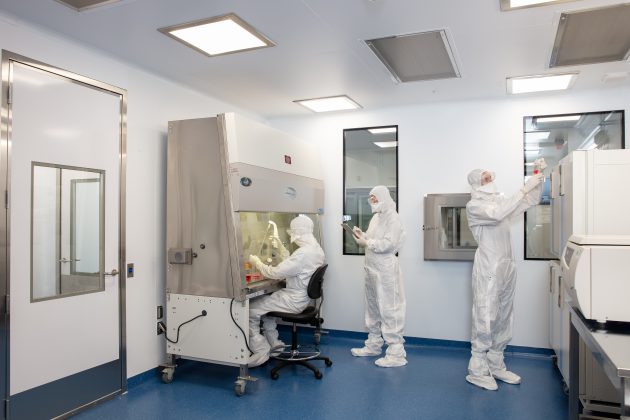
Toronto accelerator fosters made-in-Canada approach to cell therapy
by Will Mazgay, Editor
Through contract manufacturing and investment, CCRM aims to realize economic and health benefits of technologies that use living cells to cure and treat diseases

Operators in a clean room in CCRM’s Centre for Cell and Vector Production, a good manufacturing practices facility located in the MaRS Centre in downtown Toronto. PHOTO: CCRM
TORONTO — The global pandemic has put the spotlight on health sciences and their importance to the economy.
This is according to Michael May, president and CEO of CCRM, a Toronto-based accelerator that develops and commercializes cell and gene therapies and regenerative medicine technologies.
May said, “COVID-19 has put a microscope on healthcare as a driver of not only the economy but something that can impact our lives regardless of what we’re doing.”
He continued, “It has put a positive lens on healthcare and life sciences and is helping us articulate that this is an important thing to invest in.”
However, May notes that Canada imports most of its healthcare expertise, something that CCRM is aiming to change.
CCRM, a not-for-profit public-private partnership, has been around for 10 years. May said the organization aims to realize both economic and health benefits from Canada’s strength in regenerative medicine and cell and gene therapies, utilizing living cells as the basis for cures and treatments of diseases.
“Canada has been strong in the science of regenerative medicine for decades. CCRM’s mission is to leverage that scientific excellence into commercial excellence,” May said.

Michael May, CCRM
He explained that CCRM started by building a consortium of academic partners and accessing their intellectual property. Then CCRM built an industry consortium of over 100 companies from around the world.
May said, “We’ve leveraged the reputation of those scientists, and the engagement of industry to attract risk capital … It’s really that private capital that fuels our commercialization model, not just the seed funding that we got from the [federal] government to start CCRM 10 years ago.”
When it comes to CCRM’s specific functions, the organization focuses on strategic company creation, through finding intellectual property from academic partners and transforming it into viable commercial enterprises.
May said, “If you were to think of traditional tech transfer, they’re very reactive. A scientist invents something, then they try to do something with it. We look at what the market needs and we think strategically what companies would fill a gap in the industry.”
May said this process boils down to “finding technologies, advancing them, and derisking them in bundles for investment or for licensing from big industry players.”
CCRM also provides contract manufacturing for companies in Canada, the U.S. and around the world, which May said allows the accelerator to generate revenue and stay sustainable without government funding, in addition to building up its capabilities to better support company creation.
“We’ve embedded a lot of expertise in our staff, and we have labs and manufacturing facilities that are unique,” May said.
CCRM has a partnership with Cytiva (formerly GE Healthcare) and other technology partners to focus on developing the tools used to manufacture cells. “So the devices, the bioreactors, the unit operations, and then that team also does fee-for-service work with therapeutics companies to scale up their manufacturing or automate it,” said May. This is an over $50 million initiative with funding by the federal government.
The organization also has a partnership with the University Health Network in Toronto. Last summer, the tandem launched a facility to make human cells for therapeutic use, “under good manufacturing practice, it’s a very clean environment, people working in it are double suited and gowned to protect the cells so they can be put into humans.”
May said the facility has 10 rooms, two of which are dedicated to manufacturing helpful viruses.
“We all know viruses as what makes us sick, but viruses are very good at putting their genetic material into cells, so we can actually make use of safe viruses to put genetic material into cells to genetically engineer them.”
Looking to the future, CCRM is planning to create Canada’s first commercial-scale factory for making cells in southern Ontario. “We’re putting together the investor group and the strategic partners to realize this,” May said.
He continued, “This will be hundreds of thousands of square feet, and it will employ hundreds of individuals not only to provide Canadians with these products at commercial-scale, but also serve North America and the world, where manufacturing is still a major gap in the commercialization of these therapies.”
In addition to creating companies and facilitating manufacturing, CCRM acts as an investor, taking a stake in every company it creates.
“Over the last several years we’ve helped launch 11 companies. Those 11 companies have raised about $700 million and one of those companies has exited onto the NASDAQ, providing CCRM with a nice return and the ability to expand our investment activities”
May said that across CCRM’s core activities, the organization is looking to expand its reach internationally. “Because of what we’ve built in Ontario and in Canada, and the global partners that we have, our grand plan is to leverage the hub we’ve created and build a network of hubs around the world, almost franchise what we’re doing, in order to build a global network.”
He continued, “All of these hubs will represent markets that our companies will need to access. We can transplant our manufacturing capabilities around the world, and Canada can really be a major enabler and leader on the manufacturing side.”
May explained that CCRM’s activities are critical to creating Canadian companies and keeping them here. “We believe if we have domestic investment in the companies we create, and we have manufacturing capabilities, then when we create a company in Canada it will stay in Canada.”
In particular, he said that creating local manufacturing capabilities produces a “stickiness” that encourages CCRM’s companies to maintain Canadian operations, keep intellectual property on this side of the border and keep contributing to the Canadian economy.
“What happens in our field and a lot of knowledge-based industries is we’re very good at inventing things, we’re very good at the science, and then the science gets prematurely licensed to places like Boston or San Francisco where capital is readily available, and we lose the ability to generate the right kind of returns,” May said.
May explained that the COVID crisis has shown just how important creating and maintaining local manufacturing is. “If you don’t have domestic manufacturing you run risk that you are relying on others to do manufacturing for you. It represents a domestic security issue.”
May concluded that Canada has great potential in the fields of cell and gene therapy and regenerative medicine, and cultivating that potential is critical to ensure we as a country have the resources required — the manufacturing capacity, the human capital, the intellectual property and technological know-how — to solve critical health science problems, both here in Canada and around the world.